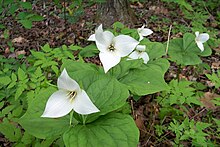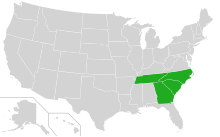Trillium simile
| Jeweled wakerobin | |
|---|---|

| |
| Scientific classification | |
| Kingdom: | Plantae |
| Clade: | Tracheophytes |
| Clade: | Angiosperms |
| Clade: | Monocots |
| Order: | Liliales |
| Family: | Melanthiaceae |
| Genus: | Trillium |
| Species: | T. simile |
| Binomial name | |
| Trillium simile | |

| |
| U.S. distribution of Trillium simile | |
| Synonyms[2] | |
Homotypic synonyms
| |
Trillium simile, the jeweled wakerobin,[3] is a species of flowering plant in the family Melanthiaceae. It is endemic to the southeastern United States. It is also known as sweet white wake-robin, sweet white trillium and confusing trillium.
Description
Trillium simile is a spring-flowering perennial plant.
Taxonomy
Trillium simile was described by Henry A. Gleason in 1906.[4]
Distribution and habitat
Trillium simile is endemic to the southeastern United States. It occurs in the southern Appalachian Mountains in the U.S. states of Tennessee, Georgia, North, and South Carolina.[5] It prefers moist humus-rich soils at the edges of Rhododendron thickets in mature forests. It is found at elevations of 500–700 meters (1,640–2,300 feet).[6]
Bibliography
- Gleason, Henry Allan (July 1906). "The pedunculate species of Trillium". Bulletin of the Torrey Botanical Club. 33 (7): 387–396. doi:10.2307/2478819. hdl:2027/hvd.32044106472392. JSTOR 2478819. Retrieved 8 December 2021.
References
- ^ NatureServe (6 December 2024). "Trillium simile". NatureServe Explorer. Arlington, Virginia. Retrieved 16 December 2024.
- ^ "Trillium simile Gleason". Plants of the World Online. Royal Botanic Gardens, Kew. Retrieved 16 December 2024.
- ^ NRCS. "Trillium simile". PLANTS Database. United States Department of Agriculture (USDA). Retrieved 15 December 2015.
- ^ Gleason (1906), p. 391.
- ^ "Trillium simile". State-level distribution map from the North American Plant Atlas (NAPA). Biota of North America Program (BONAP). 2014. Retrieved 16 December 2024.
- ^ Case Jr., Frederick W. (2002). "Trillium simile". In Flora of North America Editorial Committee (ed.). Flora of North America North of Mexico (FNA). Vol. 26. New York and Oxford: Oxford University Press. Retrieved 16 December 2024 – via eFloras.org, Missouri Botanical Garden, St. Louis, MO & Harvard University Herbaria, Cambridge, MA.
External links
- Citizen science observations for Trillium simile at iNaturalist
- Pistrang, Mark. "Sweet white trillium (Trillium simile)". United States Forest Service. Retrieved 22 September 2021.

